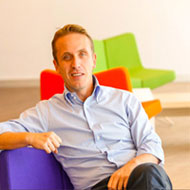Robo talk
5 April 2018
Chatbots, personalised communications and making operations faster, more reliable and cheaper. These are just some of the features of Artificial Intelligence (AI) and robotics, a technology that has dramatically changed the way banks go about their business. ING recently appointed a global head of AI and Robotics, Görkem Köseoğlu. We caught up with Görkem to find out more.
Much has been made of banks saving millions on AI and robotics initiatives by saving on processes and people. But do customers actually benefit from AI and/or robotics?
AI and robotics is about two things. Firstly, to help customers and us as a bank to be a step ahead, and secondly for process standardisation and optimisation. So, it's not only about efficiency, it’s also about effectiveness.
If you talk about customer benefits there are many examples (see box out), but also, you see changing customer behaviours. More and more, people are doing their searches by voice with devices like Amazon's Alexa and Google Home. They expect more predictive capabilities in their products and services, so for us meeting that customer demand is important.
Humans easily get frustrated by machines that don’t provide the personal touch that humans do. Is this a problem?

Görkem Köseoğlu
Yes. But we say it’s not AI versus people, but AI plus people. It’s about augmenting intelligence, especially when it comes to client service and customer engagement. It’s how we interact with customers, how we design the customer journey, the user experience... these are the things we’re learning. For different customer segments we need to tailor our language differently. For some, we can have more open-ended questions and answers, for others a list of options. In any case, the handover between chatbot and the actual person is critical.
So it can be frustrating, but there is enormous progress on both sides. People are getting used to it. At the same time companies are building more and more know-how there. More than 50 percent of searches now are done by voice, so people are shifting from keyboard to more natural interactions with machines. This is a huge shift.
Chatbots and conversational interfaces seem to be the biggest trends for banks and financial institutions. What do you think we’ll be talking about in say five years?
The next phase of chatbots is that computing becomes available anywhere, as part of our daily life. We call it ubiquitous computing. Currently, you still need to speak to a machine. Maybe in the future you won’t have to speak to a machine. It’s just something that you wear or even part of your thoughts.
The second big trend is making AI really personal. So people using AI as their personal assistant, their daily assistant, managing their day, their travel, their calendar. What would it mean for banks? That we need to personalise much more still to be part of that daily cycle for people.
How difficult is it for ING to keep ahead of the competition when banks and other major players are now throwing hundreds of millions of dollars at AI and robotics?
We’re actually one of the most innovative banks still. Everyone is launching big projects in this area, but ING’s huge advantage is its culture. This comes from the 1990s with ING Direct. Also, our Agile journey and other initiatives. We have a great culture of pushing the boundaries and challenging the status quo. That’s not easy to replicate for others.
As a result of this innovation, as a brand we’re really seen as one of the best banks in the market by customers and by potential colleagues. That’s a huge advantage as well.
But we have a huge amount of work to do as a bank. It’s not only about our AI capabilities but also about all the enablers around data, technology, tooling, all the platform work we’re doing. These will be critical components of our success.
Where do new ideas in this area come from?
I have literally tens of ideas coming into my mailbox since I was put into this role. That’s part of our culture as well. There are many employees thinking of new things and coming up with ideas.
We’re now in a position to structure our energies and these ideas. We need structure and vision. What kind of bank do we want to be? We’ve been through a phase where we put in our bets and did trials. There are plenty of ideas everywhere. It’s a matter of designing how they fit into our strategy. Where the value is. Especially in banking, the name of the game is execution. If you can bring things into market then you really make the difference.
ING has around 250 data scientists globally working on various data-science projects. Is there a ‘war on talent’ to get the brightest and best working at ING?
That 250 is the number of people officially working on data science-related projects. There are many more people who are in different roles working with data and data science-related things. There is hidden talent that needs to surface within the organisation.
Being the Best Bank in the World, we’re able to attract real top talent from all over the world. People want to work for ING. We have over 37 million customers around the world, we have plenty of data, plenty potential to change things in banking. There is huge potential.
Our plans are for a global model. Not only to grow in head office in Amsterdam, but build hubs in different locations. We’re currently looking at those.
In the future, it will be more and more difficult to attract talent. We know that. Everyone is working on similar things. We need to keep investing in our talent profile, but also surface all the internal talent we have.
